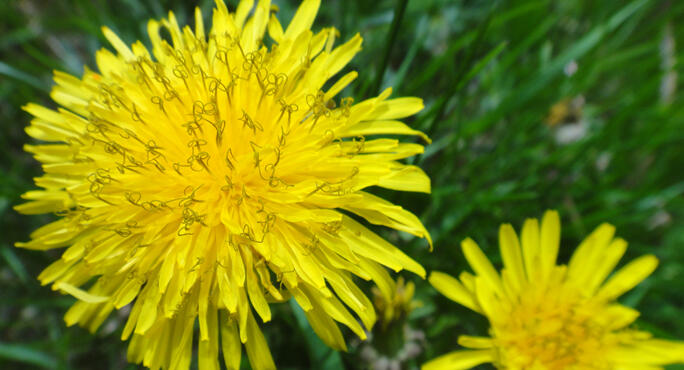
Photo by Zoe Helene
Common Name
Botanical Name
What is it?
Dandelion is a perennial herb native to Europe, naturalized in North America, and found in abundance found growing wild in meadows, pastures, fields, gardens and along roadsides. The bright yellow blossoms of dandelion are among the most readily recognized flowers in the world. Dandelion for commerce derives mainly from Bulgaria, Hungary, Poland, Romania, the former Yugoslavia.2,5 Dandelion root with herb consists of the entire plant Taraxacum officinale gathered while flowering, and its preparations.1,2,3
Dandelion has a long history of traditional use in many systems of medicine as a diuretic, laxative and antirheumatic, and to stimulate liver function, improve digestion, and reduce swelling and inflammation.3 Dandelion was employed broadly by Native Americans as a poultice to treat ulcers, and as an infusion to purify blood, to calm nerves, as a laxative tonic, to reduce back pain, to improve kidney function, as a spring tonic, and for overall well being.6
Phytochemicals and activities
Dandelion root contains novel eudesmanolides including tetrahydroridentin B and taraxacolide-B-D-glucopyranoside, sesquiterpene lactones, triterpenes, carotenoids including lutein, the flavonoids apigenin, quercitin and luteolin, the phenolic acids caffeic acid and chlorogenic acid, and the phytosterols sitosterol, stigmasterol, and taraxasterol.2,4,5,7,8
Phytochemicals in dandelion demonstrate antioxidant, antiinflammatory, antimutagenic, anticancer, analgesic, antirheumatic, antiedemic, laxative, hepatoprotective and other properties.7,8,9
Approved Uses
The Commission E approved the internal use of dandelion root with herb for disturbances in bile flow, stimulation of diuresis, loss of appetite, and dyspepsia.9,10
ESCOP indicates its use for restoration of hepatic and biliary function, dyspepsia, and loss of appetite.8
References:
- Leung, A.Y. and S. Foster. 1996. Encyclopedia of Common Natural Ingredients Used in Food, Drugs, and Cosmetics, 2nd ed. New York: John Wiley & Sons, Inc.
- Wichtl, M. and N.G. Bisset (eds.). 1994. Herbal Drugs and Phytopharmaceuticals. Stuttgart: Medpharm Scientific Publishers.
- Bown, D. 1995. Encyclopedia of Herbs and Their Uses . New York: DK Publishing, Inc. 323.
- Bruneton, J. 1995. Pharmacognosy, Phytochemistry, Medicinal Plants. Paris: Lavoisier Publishing.
- British Herbal Pharmacopoeia (BHP). 1996. Exeter, U.K.: British Herbal Medicine Association.
- Moerman, D., Native American Ethnobotany. 1st ed., (Portland, Oregon Timber Press 1998) 580
- Dr Duke’s Phytochemical and Ethnobotanical Databases
- ESCOP. 1997. Monographs on the Medicinal Uses of Plant Drugs . Exeter, U.K.: European Scientific Cooperative on Phytotherapy.
- Blumenthal M, Goldberg A, Brinckmann J (eds). Herbal Medicine: Expanded Commission E Monographs. 1st ed., (Newton, MA: Integrative Medicine Communications. 2000): 148-149.
- Blumenthal M, Busse W, Goldberg A, Gruenwald J, Hall T, Riggins CW, Rister RS (eds.). The Complete German Commission E Monographs: Therapeutic Guide to Herbal Medicines. S. Klein, R.S. Rister (trans.). 1st ed., (Austin, TX: American Botanical Council. 1998)

